Owning a new car is an exciting milestone. It guarantees freedom on the road and is often a sizable investment. However, the key to keeping that “brand new” charm alive lies in proper maintenance. By staying proactive with your car’s upkeep, not only will you increase its lifespan, but you’ll also save money on costly repairs in the long run.
Understanding Your New Car
Read the Owner’s Manual
Your car’s owner’s manual is a treasure trove of information specific to your vehicle. Popularly overlooked, this booklet contains everything you need to know—oil types, suggested maintenance schedules, tire pressure guidelines, and more.
Take some time to familiarize yourself with the manual. Skimming through it can save you unnecessary trips to the repair shop and help you feel confident when something goes awry.
Pro Tip: Bookmark sections you’ll reference often, such as “maintenance schedules” or “troubleshooting.”
Know Your Warning Lights
Warning lights are your car’s way of communicating issues. Yet, for many, they’re a source of confusion. Here’s a quick overview of the key warning indicators to note:
- Check Engine Light: Signals a wide range of issues, from a loose gas cap to engine trouble. Don’t ignore this one.
- Oil Pressure Warning: Indicates low oil pressure, which needs immediate attention to prevent engine damage.
- Tire Pressure Monitoring Light: Alerts you when tire pressure is too low or too high.
- Battery Light: Points to issues with your car’s charging system.
Understanding these signals ensures you can respond promptly and confidently when something comes up.
The Basics of Car Maintenance
Regular Fluid Checks and Changes
Fluids keep your vehicle running smoothly, so regular checks are essential. Here’s a breakdown of typical fluids and their maintenance schedules:
- Engine Oil: Check monthly and change it as per your manual’s recommendation, typically every 5,000–7,500 miles.
- Coolant: Monitor levels every few months to prevent the engine from overheating.
- Brake Fluid: Look for clear, clean fluid—dark fluid can indicate it’s time for a change.
- Windshield Washer Fluid: This one’s easy to top up yourself and crucial for visibility.
Routine fluid checks will protect your car’s essential systems and improve overall performance.
Tire Maintenance and Rotation
Tires support the vehicle’s weight, absorb road shocks, and provide traction for safe driving. Proper tire care is critical.
- Rotation: Rotate your tires every 6,000–8,000 miles to ensure even wear.
- Pressure: Incorrect tire pressure leads to blowouts or reduced fuel efficiency. Use a pressure gauge monthly to keep them inflated to the levels specified in your manual.
- Tread Depth: Place a penny into the tread groove. If Lincoln’s head is visible, it’s time for new tires.
Healthy tires keep you safer on the road and can even save money on gas by improving fuel efficiency.
DIY Maintenance for New Car Owners
Replace Windshield Wipers Yourself
Worn-out wipers reduce visibility during rainstorms, making driving dangerous. Replacing wipers is an easy DIY task:
- Purchase wipers designed for your car’s make and model.
- Follow the instructions in your owner’s manual to detach the old wipers and secure the new ones.
Check wipers regularly and replace them every 6–12 months or sooner if they streak or squeak.
Check Battery Health and Replace If Needed
A dead battery often strikes unexpectedly, leaving you stranded. Prevent this by checking your car’s battery health every few months.
- Look for corrosion on terminals and wipe it off with a baking soda solution (or ask your maintenance provider for help).
- Invest in a battery tester to periodically monitor its output.
If your battery is more than 3–5 years old, consider replacing it before it fails.
The Benefits of Regular Professional Maintenance
Regular Oil Changes
While some tasks are DIY-friendly, oil changes are best handled by professionals. They ensure proper disposal of old oil and check additional components like filters. Stick to the intervals recommended in your owner’s manual for the best results.
Brake Inspections and Servicing
Your safety depends heavily on functional brakes. Professionals can check for pad wear, rotor condition, and fluid levels to ensure your brakes stay responsive.
Brakes should be inspected at least once a year or whenever you notice a decrease in stopping performance, unusual noises, or vibration. For professional brake repair, trust experts, such as those in Salem, Utah, to ensure your safety on the road.
Scheduled Maintenance Services
Manufacturers provide a schedule tailored to your car. These services cover essential areas like engine tuning, spark plugs, and suspension systems. Think of it as a checkup to maintain your car’s health.
Regular visits to a certified service provider ensure small issues don’t snowball into expensive, hard-to-fix problems.
Long-Term Maintenance Tips for New Cars
Protect Your Car’s Exterior and Interior
Preserve your new car’s shine and upholstery with the following tips:
- Wash and wax the exterior regularly. Waxing every three months keeps the paint gleaming and protects it from environmental damage.
- Use seat covers or protectants to safeguard the interior from spills, fading, and wear.
- Vacuum the interior periodically to prevent dust buildup.
Prepare for Seasonal Changes and Road Trips
Different seasons and long drives pose unique challenges for your car.
- Winter: Check antifreeze levels, keep an eye on tire tread, and clear snow from your windshield and headlights.
- Summer: Maintain your air conditioning system and keep your coolant at optimal levels.
- Road Trips: Inspect tires, change the oil, and pack an emergency toolkit before heading out.
Proactive preparation ensures you handle harsh weather conditions and extensive travel without a hitch.
Conclusion
Mastering car maintenance doesn’t have to be overwhelming—especially if you start with the basics. By taking simple yet proactive steps like understanding warning lights, checking fluids regularly, and partnering with professionals, you’ll enjoy smooth rides for years to come.
